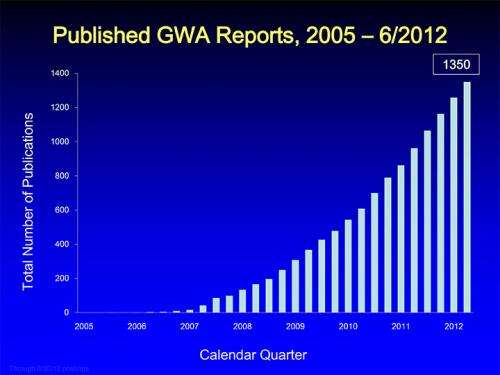Discovery of genetic and environmental links to lymphomas

In 2001, Christine Skibola, Ph.D., now a professor of epidemiology at the University of Alabama at Birmingham School of Public Health, joined forces with a small group seeking a large goal – discovery of genetic and environmental links to the white blood cell tumors that collectively are called lymphomas.
This has now resulted in the largest epidemiology and genetic studies of non-Hodgkin lymphoma (NHL) ever conducted. Thus far, these studies have culminated into four genetics papers published in Nature Genetics, American Journal of Human Genetics and Nature Communications, and an entire monograph in the Journal of the National Cancer Institute Monographs comprising 13 papers on environmental and medical risk factors found to be associated with various lymphoma subtypes. More papers are on the way.
This sort of research is huge in scale. The hundreds of investigators involved did risk factor analysis and genome-wide association studies on more than 17,400 NHL cases and 23,000 matched controls from North America, Europe and Australia. Two recent Skibola papers, for example, included 140 different authors at 82 different universities, institutes or hospitals that were located in 16 U.S. states and 18 foreign countries.
"This is what it takes now to get the large power to detect true associations in most cases," Skibola said.
Those results – finding links to personal and family histories, or associations with individual genetic markers – set the path for future research and future possible treatments.
Consider the stark difference in risk profiles discovered by Skibola and others for two of the most common types of NHL – diffuse large B-cell lymphoma (DLBCL) and follicular lymphoma (FL).
On the one hand, when researchers looked at risk factors related to medical history, lifestyle, family history and occupation, the DLBCL patients had numerous significant risks. These included being obese as a young adult, having a history of any one of a number of autoimmune diseases and a family history of a blood cancer. Other factors, such as allergic conditions, a history of alcohol consumption or a previous blood transfusion for men, and hormone replacement therapy or oral contraceptive use for women, gave some protection from DLBCL. In contrast, only a few, modest epidemiology risk factors were found for FL.
On the other hand, when researchers looked at risk factors associated with genetic changes, the tables were reversed: FL had a number of profound genetic risk factors and DLBCL had much less.
"We never expected to see such different risk profiles," Skibola said. She said that common gene variants in the human leukocyte antigen (HLA) system were very significantly associated with increased risk of FL. This suggests that FL may be more like an autoimmune disease, which may alter how clinicians consider treating patients in the future. (Genes of the HLA system encode for cell-surface proteins involved in regulating the human immune response, and some HLA types are associated with various autoimmune disorders.)
"Hopefully, findings from these studies may someday be used to identify high-risk populations that can be more closely screened for lymphoma," Skibola said. "Also, the genetic studies may provide clues in the identification of new therapeutic targets."
The discovery of genetic risk factors for the NHL project required multiple genome-wide association studies (GWAS). This experimental approach is a booming field of medical research: the first GWAS was published in 2005 and by June 2012 the number of published reports had surged to 1,350.
In general, a GWAS is a way to identify specific spots in the genome that are associated with a disease. Researchers have mapped more than a million places on the human genome where the DNA may have a single base-pair change, and each of these points serves as a "milepost." If any of these nucleotide variants are statistically more frequent in people with disease, as compared with matched controls who are healthy, it suggests that a nearby gene, or a nearby part of the genome involved in gene regulation, may play a role in the disease.
Finding a genetic association is only the start for researchers.
"This is just the tip of the iceberg," Skibola said. "These findings yield new clues to the causes of various types of lymphoma. We're off to a good start and now the real work begins."
NHL is a mosaic of closely-related, subtype-specific diseases, each with distinct molecular traits, and separate genetic and clinical features. More than 500,000 people a year worldwide are diagnosed with NHL. Skibola's publications have focused on four of the largest subtypes of NHL: diffuse large B-cell lymphoma, follicular lymphoma, chronic lymphocytic leukemia and marginal zone lymphoma. Other types of lymphoma are still under investigation.
Overall, the International Lymphoma Epidemiology Consortium, or InterLymph, examined 11 NHL subtypes in this massive project. InterLymph is an open scientific forum, so all of the work Skibola and others have done will be a pooled data resource for future investigators.
"These data will certainly be mined by many researchers in the future," Skibola said. "I expect much more will be gleaned from these studies in the years to come."
More information: "Genome-wide association study identifies multiple risk loci for chronic lymphocytic leukemia." Nat Genet. 2013 Aug;45(8):868-76. DOI: 10.1038/ng.2652. Epub 2013 Jun 16.
"Genome-wide association study identifies multiple risk loci for chronic lymphocytic leukemia." Nat Genet. 2013 Aug;45(8):868-76. DOI: 10.1038/ng.2652. Epub 2013 Jun 16.
"Genome-wide Association Study Identifies Five Susceptibility Loci for Follicular Lymphoma outside the HLA Region." Am J Hum Genet. 2014 Oct 2;95(4):462-71. DOI: 10.1016/j.ajhg.2014.09.004.
"Advancing the Science of Integrative Oncology to Inform Patient-Centered Care for Cancer Survivors." J Natl Cancer Inst Monogr (2014) 2014 (50): 283-284 DOI: 10.1093/jncimonographs/lgu038

















